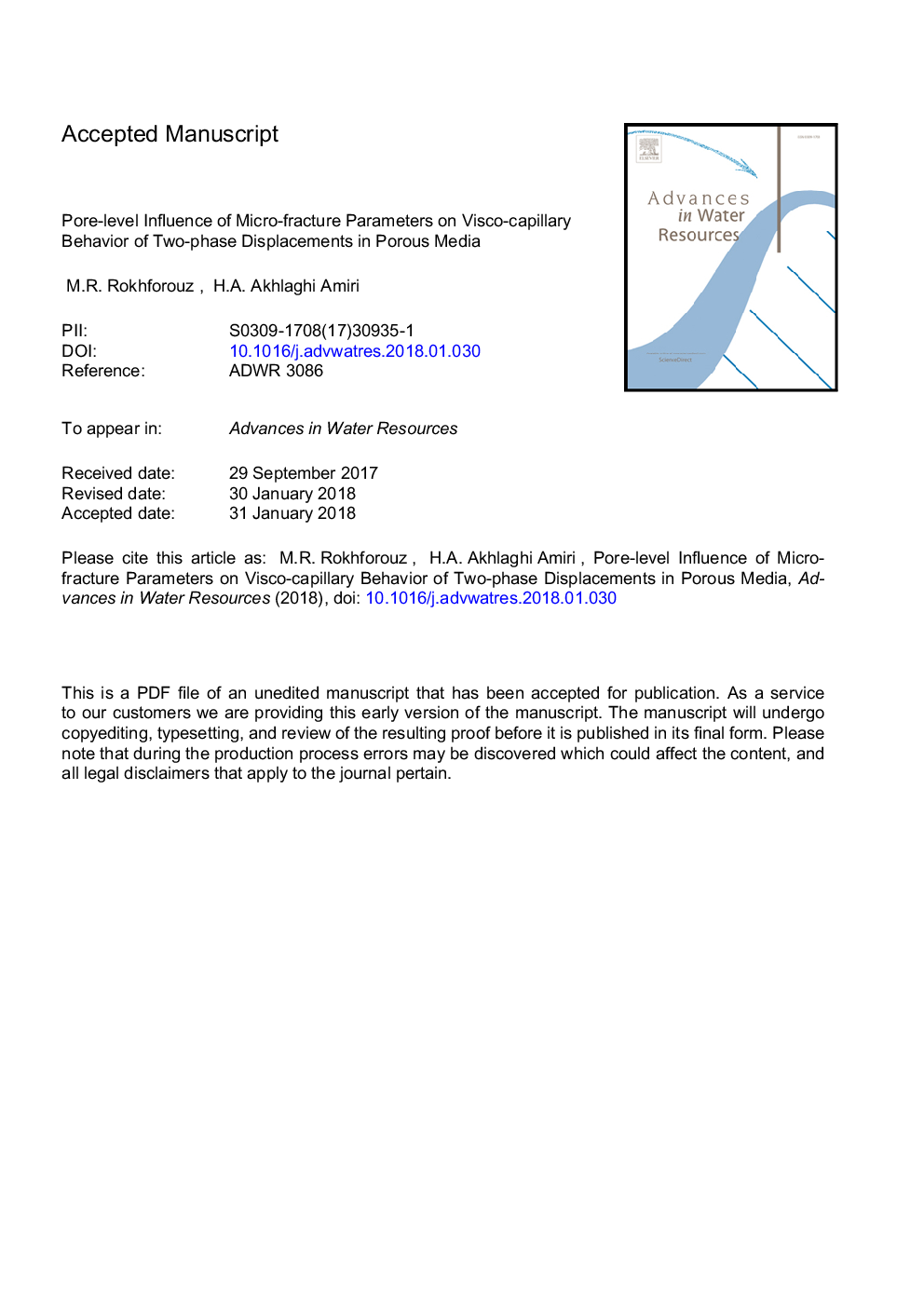| کد مقاله | کد نشریه | سال انتشار | مقاله انگلیسی | نسخه تمام متن |
|---|---|---|---|---|
| 8883363 | 1625598 | 2018 | 31 صفحه PDF | دانلود رایگان |
عنوان انگلیسی مقاله ISI
Pore-level influence of micro-fracture parameters on visco-capillary behavior of two-phase displacements in porous media
ترجمه فارسی عنوان
تأثیر پارامترهای شکستگی میکروسکوپی بر رفتار ویسکو-مویرگی جابجایی های دو فاز در رسانه های
دانلود مقاله + سفارش ترجمه
دانلود مقاله ISI انگلیسی
رایگان برای ایرانیان
کلمات کلیدی
محیط متخلخل متخلخل، روش فاز فیلد دو فاز جریان، انگشت موی سر، انگشت چسبناک، رطوبت
موضوعات مرتبط
مهندسی و علوم پایه
علوم زمین و سیارات
فرآیندهای سطح زمین
چکیده انگلیسی
In this work, coupled Cahn-Hilliard phase field and Navier-Stokes equations were solved using finite element method to address the effects of micro-fracture and its characterizations on water-oil displacements in a heterogeneous porous medium. Sensitivity studies at a wide range of viscosity ratios (M) and capillary numbers (Ca), and the resultant log Ca-log M stability phase diagram, revealed that in both media, with/without fracture, the three regimes of viscous fingering, capillary fingering and stable displacement similarly occur. However, presence of the fracture caused water channeling phenomenon which resulted in reduction of the number of active fingers and hence the final oil recovery factor. At high Ca (especially in the stable regime, with log Caâ¯â¥â¯â2.5 and log Mâ¯â¥â¯0), recovery factor for the fractured medium was relatively identical with the non-fractured one. At log Mâ¯â¥â¯0, the fracture was fully swept, but flow instabilities were observed inside the fracture at lower M values, especially for log Caâ¯>â¯â4.6. In the case of the fractured medium at log Caâ¯=â¯â4.6 and log Mâ¯=â¯0 (capillary dominant flow), it is observed that the primary breakthrough took place by a finger progressed through the matrix, not those channeled through the fracture. Geometrical properties of the fracture, including length, aperture and orientation, highly affected both displacement profile and efficiency. The fracture length inversely influenced the oil recovery factor. It was observed that there is a critical fracture width (almost half of the medium average pore diameter) at which the recovery factor of the medium during displacement is minimum, compared to the media having thinner and thicker fractures. Minor channeling effect in the media with thinner fracture and larger fracture swept volume as well as high fracture/matrix cross flow in the media with thicker fracture were detected as the main cause of this non-monotonic behavior. In the models with thick fractures (with the thickness higher than the average pore diameter), considerable trapped oil volumes were observed inside the fracture at low M values. The fracture orientation had the most impressive effect on oil recovery compared to the other studied parameters; where the oil recovery factor incremented more than 20% as the fracture rotated 90° from flow direction. Due to the dominant effect of the channeling phenomenon, the change in the medium wettability from slightly oil-wet to slightly water-wet, did not considerably affect the displacement profile in the fractured medium. However, oil recovery factor increased as the medium became more water-wet. The fracture area was fully swept by the injected water in the oil-wet and neutral-wet media. However, flow instabilities were observed inside the fracture of the water-wet medium due to counter-current imbibition between fracture/matrix. Micro-scale mechanisms of pore doublet effect, interface coalesce, snap-off and reverse movements were captured during the studied unstable displacements.
ناشر
Database: Elsevier - ScienceDirect (ساینس دایرکت)
Journal: Advances in Water Resources - Volume 113, March 2018, Pages 260-271
Journal: Advances in Water Resources - Volume 113, March 2018, Pages 260-271
نویسندگان
M.R. Rokhforouz, H.A. Akhlaghi Amiri,
